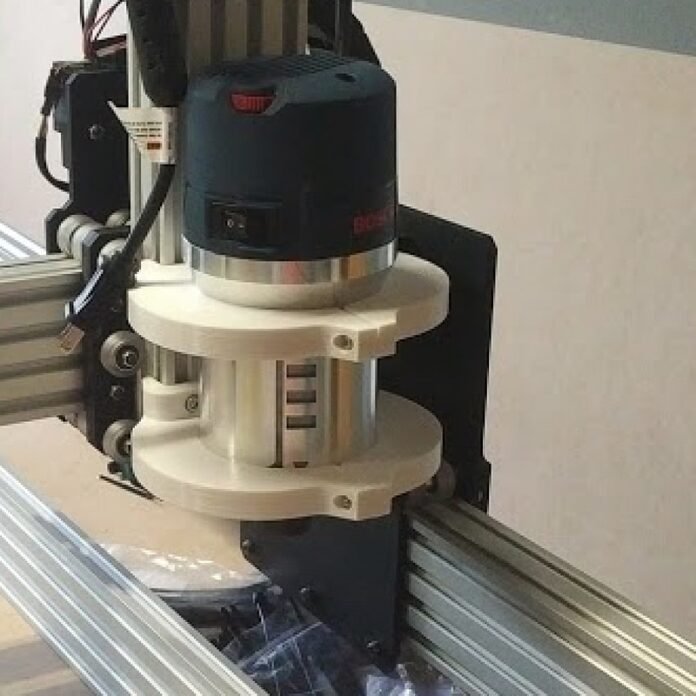A CNC (Computer Numerical Control) spindle is an integral part of many machining operations, responsible for rotating the cutting tool and delivering precise, reliable cuts across various materials. However, spindles are also one of the most common components to experience wear and tear, affecting both performance and productivity. Recognizing when your CNC spindle needs repair—or even spindle replacement—can help you avoid costly downtime and extend the life of your equipment. This guide outlines the key signs that your CNC spindle may need attention and offers tips to address these issues proactively.
Table of Contents
1. Unusual Noises or Vibrations
One of the first indicators of spindle issues is an unusual noise. CNC spindles are built to operate smoothly and quietly, so if you hear grinding, rattling, or humming sounds, it’s worth investigating. Such noises often signal that the bearings within the spindle are wearing down, which, if left unattended, can lead to more severe damage or even complete spindle failure.
Vibrations are another red flag. High-speed spindles are particularly sensitive to imbalances, so even minor vibrations can cause issues. If the vibration persists, it can compromise cutting accuracy, affect the quality of your parts, and potentially damage other machine components.
Solution: Regular maintenance and lubrication can help reduce bearing wear. If noises or vibrations persist, consult a technician to assess whether repairs are sufficient or if a spindle replacement may be necessary.
2. Decline in Machining Precision
Precision is one of the hallmarks of CNC machining, so a noticeable drop in the accuracy or quality of your cuts can indicate spindle problems. Often, this is due to wear in the bearings or misalignment in the spindle’s components. Inaccurate machining can result in parts with incorrect dimensions, leading to wasted material and time.
Solution: To address precision issues, check for misalignments in your spindle and related components. Realigning the spindle can sometimes resolve the problem, but if wear on the bearings is extensive, a spindle replacement might be more cost-effective in the long run.
3. Excessive Heat Generation
Spindles operate at high speeds and, as a result, generate heat. However, if your spindle is generating excessive heat, it could be a sign of a problem. Overheating is often caused by inadequate lubrication, which leads to increased friction within the spindle bearings. This friction can result in thermal expansion, which not only shortens the lifespan of the spindle but also affects its overall performance and precision.
Solution: Ensure that your spindle is adequately lubricated and that the cooling systems are working correctly. If overheating persists, the spindle bearings may be worn and require replacement. In severe cases, a complete spindle replacement may be necessary to restore optimal performance.
4. Visible Wear on the Spindle or Tooling
Physical inspection can also reveal when a spindle needs repair or replacement. Look for visible signs of wear, such as cracks, corrosion, or excessive wear on the spindle and tooling. Spindle wear can be caused by several factors, including improper handling, overloading, or using the spindle beyond its operational limits. Visible wear not only affects spindle performance but also poses a safety risk to operators.
Solution: Regularly inspect the spindle for any visible wear or damage and avoid overloading it. If there is significant wear, consult with a technician to determine whether repairs can extend the spindle’s life or if replacement is the safer and more reliable option.
5. Loss of Power or Speed Consistency
A CNC spindle is designed to maintain consistent speed and power output throughout its operation. A noticeable drop in speed or fluctuations in power can indicate issues with the motor, bearings, or other internal components. In some cases, the motor may struggle to reach the desired RPM (Revolutions Per Minute), which affects machining speed and efficiency. This issue can also lead to poor surface finishes and prolonged production times.
Solution: Check the spindle motor for any signs of electrical issues or wear. If power or speed consistency issues persist, you may need to consult a technician to determine if the motor needs repair. If extensive wear or damage is found, a spindle replacement might be the best course of action to maintain optimal machine performance.
6. Increase in Runout Tolerance
Runout refers to the deviation of the spindle’s rotating axis from its ideal position. Excessive runout tolerance is a common indicator of spindle wear and can cause a range of problems, including poor surface finish, reduced tool life, and decreased accuracy. Increased runout is often due to worn bearings or misaligned components within the spindle.
Solution: Check the runout tolerance with a precision measuring tool. If the deviation exceeds acceptable levels, it may be time to replace the bearings. In severe cases, the spindle itself may need replacement to restore proper alignment and precision.
Read More: Innovative Tools and Technologies for Enhanced Outdoor Experiences
7. Frequent Tool Breakages
If your tooling starts to break frequently, it could be a symptom of spindle issues. A worn or misaligned spindle can place undue stress on the tooling, leading to premature breakage. This not only increases tooling costs but also disrupts production and reduces machining efficiency.
Solution: Regularly check and maintain spindle alignment and replace worn bearings as needed. If tool breakages continue despite these efforts, consult a technician about possible spindle repairs or replacement.
8. Spindle Error Codes or Alerts
Modern CNC machines are equipped with sensors and monitoring systems that alert operators to potential issues. If your machine’s control panel displays spindle error codes or alerts, take them seriously. These codes can indicate a range of issues, from overheating to alignment problems, and addressing them early can prevent further damage.
Solution: Refer to your machine’s manual to understand the specific error code or alert. If the alert indicates a serious issue, such as a bearing failure or motor problem, consult with a technician immediately. Regular maintenance can help minimize the frequency of these alerts, but a spindle replacement may be necessary if the errors are recurring.
9. Increased Maintenance Requirements
If you find yourself spending more time and resources on spindle maintenance, it may be a sign that the spindle is nearing the end of its lifespan. While regular maintenance is essential, excessive repairs or part replacements indicate that the spindle is no longer able to perform reliably. Additionally, frequent maintenance can result in extended machine downtime, impacting overall productivity.
Solution: Track the frequency and cost of spindle repairs. If maintenance costs are becoming excessive, consider a spindle replacement. Although it’s an investment, a new spindle will restore your machine’s reliability and efficiency.
10. Extended Downtime Due to Spindle Issues
Repeated breakdowns or lengthy repairs are a clear indication that your CNC spindle is no longer reliable. Spindle-related downtime can disrupt production schedules, reduce profitability, and even cause frustration for operators. If spindle issues are leading to extended machine downtime, it may be more cost-effective to replace the spindle rather than continue with frequent repairs.
Solution: Weigh the cost of repairs against the cost of replacing the spindle. In many cases, replacing the spindle is a better long-term solution, as it reduces downtime and ensures consistent performance.
When Is Spindle Replacement the Best Option?
While repair options are available for most CNC spindle issues, there comes a point when replacement is more economical and effective. Here are some scenarios where spindle replacement might be the best choice:
- Frequent breakdowns: If spindle failures are common, replacing the spindle can restore machine reliability and reduce downtime.
- Extensive bearing wear: When bearings are worn beyond repair, a new spindle will provide a fresh start and ensure precision.
- Outdated spindle models: Newer spindles often come with improved features, such as enhanced speed control, which can improve productivity and quality.
- High repair costs: If repair costs are close to or exceed the price of a new spindle, replacement is usually more economical.
Preventing Spindle Issues Through Regular Maintenance
To minimize spindle repairs and extend the life of your CNC machine, regular maintenance is key. Here are a few best practices to help prevent spindle issues:
- Lubricate Bearings Regularly: Ensure that the spindle bearings are adequately lubricated to reduce friction and overheating.
- Monitor Runout Tolerances: Regularly check runout to ensure alignment and avoid excessive wear.
- Avoid Overloading: Operate within the spindle’s specified limits to prevent damage from excessive load or speed.
- Check Cooling Systems: Proper cooling helps control spindle temperature and prevent overheating.
- Schedule Routine Inspections: Routine inspections by a qualified technician can catch early signs of wear and help prevent costly repairs.
Final Thoughts
A well-maintained CNC spindle can significantly improve machining accuracy, extend tooling life, and reduce downtime. By staying vigilant for signs of spindle wear and addressing issues early, you can avoid costly repairs and maximize the productivity of your CNC machine. However, when repairs become frequent or costly, spindle replacement may be the best choice to ensure optimal machine performance.
A healthy spindle means a healthy machine, so be proactive with maintenance and consult a professional when in doubt.
Apart from that, if you are interested to know about “reasons to buy Rado watches” then visit our “Technology“category.
















